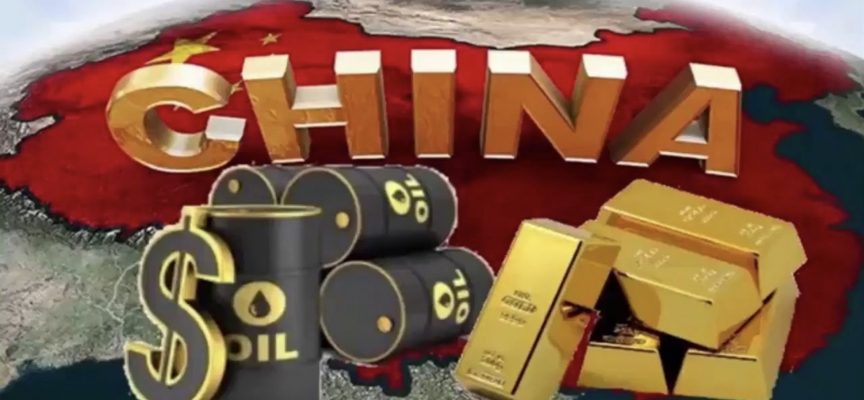As the US/China Trade War heats up, China is preparing to launch a new monetary system centered around gold.
A New Monetary System Centered Around Gold
June 2 (King World News) – Dr. Stephen Leeb: “The tensions between China and the U.S. have intensified into what some are calling a Cold War. Technology supremacy is at the center of the battle. The U.S. has decided that China threatens America’s putative supremacy in tech and wants to beat it back. One apparent U.S. aim is destruction of Chinese tech icon Huawei.
And with this Cold War, we should have no illusions about the outcome – we’re likely to lose. That’s because, unfortunately, the U.S. has been pursuing an approach that is misguided, shortsighted and could easily backfire. As with any war, hot or cold, to the winner will go the spoils. In this case, one of the spoils China will happily gain will be moving faster to a new monetary system centered around gold…
Listen to the greatest Egon von Greyerz audio interview ever
by CLICKING HERE OR ON THE IMAGE BELOW.
That in turn will deprive the U.S. of the weapon the dollar’s reserve currency status has long given it to enforce its will. The U.S. will lose the power to severely weaken foreign competition through enforcement of sanctions and the ability to limit supplies.
What is the misguided approach the U.S. is following? It’s to simply try to shut down the competition, and most notably Huawei, whose technological edge over us is apparent, rather than seeking to leapfrog it by developing even better technologies here. The danger is that if we don’t succeed in totally knocking Huawei out of contention, we will likely simply make it even stronger than before, with a more commanding lead and no need to work with American tech companies at all.
If I sound angry, it is because this is not the same great country that I grew up in. That country had to confront the Soviet Union’s successful launch of Sputnik and the revelation the Soviet Union was ahead of us in space technologies. How did the U.S. respond back then? By allocating billions of dollars to STEM education and massive R&D efforts – leading to our landing on the moon. If we’d reacted to Sputnik the way we’re now reacting to Huawei, we’d have simply shot Sputnik down, an action that would have done nothing to lessen Russia’s supremacy in space technologies.
Huawei is a remarkable company that the U.S. has been hammering with one blow after another in the name of national security, citing it as a conduit of Chinese spying. We started by restricting sales here of most Huawei products. Rural telecoms are the exception: Many telecoms in rural U.S. areas use Huawei products in their wireless networks because Huawei’s equipment is both better and cheaper than that of its competitors.

The U.S. also has sought to convince our allies around the world to shun Huawei products in their wireless networks and in particular not to let it become the backbone of 5G, which could give the company a commanding lead and possibly dominant position in digital infrastructure. Australia has sided with us; European countries, however, have been less willing to accede to U.S. cajoling and appear unconvinced by U.S. arguments about the security threat posed by Huawei.
There’s good reason for that skepticism. There has never been hard and fast evidence that Huawei has used its equipment to spy or that its equipment contains the back doors that would allow it to do so. Quite the opposite. Unlike any other telecom company, it has provided source code, which means that prospective customers, including governments, can examine in detail the software that manages Huawei products. While, admittedly there have been some technical complaints about the code, particularly from the British, there has been no evidence that the code provides backdoors that are used in security breaches.
Having failed to convince a large chunk of Europe, the U.S. has ratcheted up its efforts by moving to prevent Huawei from continuing to buy the U.S. tech components it has long used in its phones and networks. Moreover, the ban extends to products sold to Huawei by non-U.S. companies around the world if at least 25% of such products is based on knowledge or materials that had their origins within the U.S. Again, I emphasize this sway the U.S. has over foreign business practices stems completely from the role the dollar plays in worldwide trade.
How vulnerable is Huawei to such a ban? It might be less exposed than the Trump administration expects. While Huawei draws on multiple U.S. suppliers – accounting for about 14% of its costs – the company has been well aware that the U.S. might seek to cut off access and has prepared by stockpiling significant quantities of the components it sources from U.S. providers. This will give it time to both develop its own proprietary products or find other sources.
There are two areas where commentators have suggested Huawei could have problems. Huawei phones run on Google’s Android operating system, which means they also offer owners of Huawei phones the more than 2 million plus apps available from Google Play Store. Because of the just-imposed U.S. restrictions, Google has said it will stop providing updates to Android in Huawei phones and will take away access to its store.

Huawei has been preparing for the U.S. move for some time. The company has developed a substitute OS, dubbed Hongmeng, which will be fully compatible with Android applications but also leapfrog Google’s OS. It is roughly 60% faster than Android and will work on a much broader range of devices than Google’s version. These devices range from computers to cars to TV’s. Hongmeng along with Huawei’s best in market AI chips will give it a major leg up in the massive Internet of Things (IOT) market – probably the largest application of 5G.
Hongmeng will secure Huawei’s place in China, where Google apps are not used. Indeed, other Chinese smartphone manufacturers will almost surely adopt Hongmeng as well – again it is much faster than Android and already partially adapted to the IOT. Outside of China – and especially in Europe – the Huawei smartphones will initially be at a disadvantage to phones that have full access to Google apps.
One partial workaround is the Portuguese company Aptoide, which hosts over 900,000 apps. Huawei is currently in discussion with Aptoide and access could easily be added to Huawei phones. Longer term it is almost certain that app developers will want a share of the massive Chinese market and will develop apps for Hongmeng. Indeed, given the size of the Chinese market, easily the largest in the world, Hongmeng will become the first choice of many leading app developers.
A more controversial workaround would be to offer Huawei phones with a Baidu browser. The third-party browser would have access to the Google play store. Admittedly, though it is unlikely that Aptoide and/or the Baidu browser would duplicate both the breadth of the Google store and/or the ease of downloading apps and their updates. Thus, in the short-term Huawei likely would lose business in Western countries. But its market share in China, by far the company’s largest market, will likely increase. Perhaps more important, for Belt and Road countries whose population is well over 50% of the world, Huawei will be in a position to dominate the smartphone and, indeed the entire 5G arena.
Denying access to Google software, therefore, does not pose an existential threat to the company. Indeed, it might even speed up the implementation of a better OS, which the company had already been planning. And this will make Huawei’s 5G efforts even more unstoppable in the Belt and Road countries, whose population is well over 50% of the world.

Another major threat for Huawei is on the hardware side. In terms of chips that are used in both smartphones and 5G infrastructure, overall few would argue that Huawei products, across the board are equal or superior to competing products. Neither of Huawei’s leading competitors, Qualcomm and Apple, offers a complete suite of products, which include both application processors, the brains of the device, and modems, which connect the device to the outside world. While Apple makes its own application processors, they need an outside source for modems, which is Qualcomm.
Huawei, through its subsidiary HiSilicon Technologies, designs a wide variety of chips including both applications processors and modems. Each matches the best that come from Apple and Qualcomm. According the Japanese based Nikkei Asian Review, Huawei’s Kirin 980 core processor is the most advanced smartphone chip with best facial and voice recognition features and a seamlessly integrated Huawei modem. Huawei has come a long way since HiSilicon was founded just 15 years ago.
But banning Huawei from U.S. intellectual property threatens a major roadblock. Virtually all chip designers use architecture based on licensed intellectual property from English based and Japanese owned ARM. As an analogy, computer algorithms, whether for playing chess or trading the market, are designed using known software such C, Fortran, Unix, and many others. ARM’s architecture functions like software for the various designs of smartphone chips.
Though ARM is of British provenance and Japanese owned, some of its intellectual property had its origin in the U. S. and is likely subject to the ban. Without access to ARM’s intellectual property, Huawei would not have access to the periodic improvements ARM makes in its architecture. Developing new architecture is a Herculean task, and many analysts believe it would take up to five years to accomplish – a time span that would severely hamper, if not crush, Huawei’s place in the smartphone market. Moreover, 5G networking products, which are clear leaders also somewhat dependent on ARM architecture.
IMPORTANT:
To learn which junior explorer is about to release drill results that could unlock one of the biggest discoveries in the world CLICK HERE OR ON THE IMAGE BELOW
 Sponsored
Sponsored
Fortunately for Huawei, there are two potential workarounds. First there is a JV, known as ARM mini China (AmC) between ARM and a consortium of Chinese investors in which the Chinese own 51%. As with its development of Hongmeng, Huawei anticipated the ban and has access to all of ARM’s current intellectual property through its relationship with AmC. This should allow the company to proceed as planned for the next two years or so. Once ARM creates new improvements, Huawei will have two possibilities – continue to rely on AmC for updates or spin off its chip development subsidiary HiSilicon, which as a separate entity would not be subject to the ban.
In addition to intellectual property provided by ARM, Huawei is also dependent on American companies Synopsys and Cadence for electronic design automation (EDA) tools. EDA tools ensure that chip designs are fully compatible with manufacturing processes performed by foundries – in Huawei’s case, by Taiwan Semiconductor. According to the well-respected website electronicsweekly.com, “EDA software is, of course, extremely portable, and Cadence and Synopsys must have many customers in China who are willing to help Huawei out.” Were intra-China transactions conducted in dollars rather than yuan, there would be no way one could make that statement.,
Moreover, in addition to workarounds, Huawei will be working hard to develop its own architecture, software, and chips that it currently lacks. Remember, this is a company that has gone from nearly nothing to dominant in arguably the most important technology market in about 15 years.
In sum, we think the ban on Huawei is manageable and on a best-case basis for the company could even be advantageous in that it will speed up its timetable for becoming a soup-to-nuts vertically integrated company.
Still there are a lot of “ifs.” One critical question is: What happens if the U.S., through the steps it already has taken and any future unanticipated steps, succeeds in putting Huawei out of business, or at least severely crimping its sway and prospects?

Then Huawei could become an example of “be careful what you wish for.” If the U.S. is too successful in throttling Huawei, we should expect China to respond forcefully. And China has at least two aces up its sleeve to fight back in ways that could inflict serious harm on us. We should be hoping we haven’t created an existential threat to Huawei.
One potential weapon is that China could deny U.S. companies like Qualcomm, Apple, and Micron, which derive substantial chunks of revenue from sales to Chinese companies, access to the Chinese market. Qualcomm is probably the most technologically sophisticated in 5G technologies. Apple recently was virtually forced to settle a legal suit with the company for over $4.5 billion as it became apparent that no other American company could provide modems for their smartphones. Worldwide the only other supplier of 5G modems is, you guessed it, Huawei.
A ban on Qualcomm sales in China would be an obvious boon to Huawei. It would also likely cripple Qualcomm which relies on China for about 60% of its sales.
A potentially far more damaging response – one that China not so subtly broadcast loud and clear by President Xi’s recent visit to a rare earth facility – is that China could cut off U.S. access to rare earth products. China is the only fully integrated supplier of rare earths. Not only does it have the largest reserves by a wide margin but it’s the only country currently able to take these reserves through a complex supply chain whose end product is the most powerful form of permanent magnet.
Permanent magnets have a role in many modern technologies, from computers to cell phones to EVs. But in many of these applications, somewhat inferior substitutes are available and can be used.

The one area where you need the absolute best is in sophisticated military products. Our military depends on China for this supply. Meanwhile, China’s access to rare earths and the finished products made from them is total. That might explain why China, unlike the U.S., has developed guided hypersonic missiles. Yes, the U.S. has far more armaments, battleships, aircraft carriers, than China does. But according to Reuters, (The China Challenge published on April 25th, 2019: https://www.reuters.com/investigates/special-report/china-army-rockets/ the U.S. has no defenses against China’s hypersonic missiles. One comment in the lengthy report stands out. James Fanell, a retired naval senior intelligence officer states: “We know that China has the most advanced ballistic missile force in the world. They have the capacity to overwhelm the defensive systems we are pursuing.”
The Huawei saga could still end with the U.S. agreeing to drop sanctions as part of a “grand” trade war agreement. Still even this benign ending will not be so benign in the longer run. The damage is done. Huawei and other Chinese companies will work to become completely vertically integrated and not dependent on U.S. The Chinese will also put pedal to the metal when it comes to launching its gold-based monetary system. Sadly, the U.S., whether in dealing with China and Huawei or more recently even Mexico, has proved itself to be capricious and dangerous. For those countries that are using the dollar as the basis of their trade with other countries, a red flag has been raised.
Reinforces The Need To Own Gold-Related Investments
In other words, the Huawei episode sharply reinforces the need for investors to own gold-related investments. The reason is that, as we’ve discussed before, there is little doubt that China wants to establish a new monetary reserve system that replaces the dollar with some sort of basket of currencies linked to gold. Through various efforts – including its establishment last year of an Eastern oil benchmark denominated in yuan – China has been laying the groundwork for such a system.
If the world becomes bifurcated into East/West zones, which is a working assumption of many analysts, it would likely speed the transition to such a new gold-linked monetary reserve system. Initially the gold-based system would govern trade among Eastern countries but eventually given the unparallel desirability a gold-backed currency would have over the dollar, it would be a matter of time before gold ruled the entire monetary realm. Bottom line: gold is headed dramatically higher.

Gold Breaking Out In Yuan For First Time Since 2013
As a final note, our work shows that gold priced in yuan may have broken out of a very tight trading range closing a month over 9000 yuan for the first time since 2013. In my last interview with Eric, I noted that the BIS has anointed gold as a risk-free asset that banks can use as they do cash to back up their loans. The Chinese, whose banks have major gold holdings, may have decided to turbocharge this historic shift in the world’s monetary system. The case for gold has never been stronger, and the only a question is when the first break-out will take place. The evidence is growing that it could be lot sooner than most think.”
***Also just released: MAJOR ALERT: Only 2nd Time In History Commercials Go Long Silver Market CLICK HERE TO READ.
© 2019 by King World News®. All Rights Reserved. This material may not be published, broadcast, rewritten, or redistributed. However, linking directly to the articles is permitted and encouraged.








